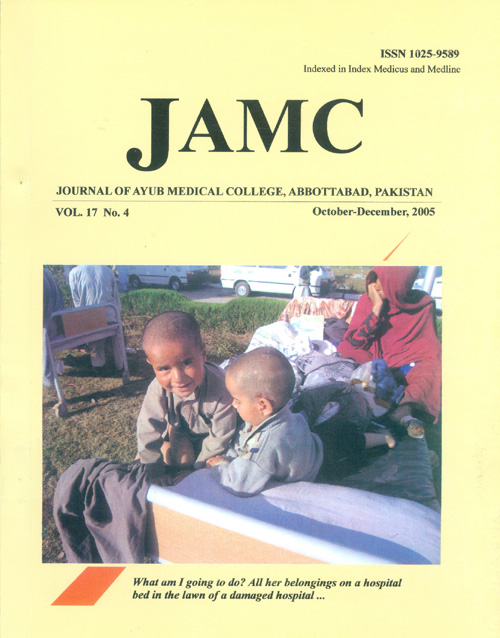AGGRESSIVE REVASCULARIZATION IN PATIENTS WITH CRITICAL LOWER LIMBS ISCHEMIA
Abstract
Background: This study was conducted to conduct an audit of our policy of aggressive arterialreconstruction in patients with critical lower limb ischemia, so as to determine the success in
treatment of these cases in terms of limb salvage and patient survival. Methods: This study was
carried out at department of general and vascular Surgery, Combined Military Hospital
Rawalpindi from January 1995 to January 2000. A total of 114 cases were studied. All patients
were admitted for assessment of an ischemic leg. Pre operative angiography was routinely
performed. All patients underwent definitive treatment (bypass surgery, amputation and lumber
sympathectomy) within three days of admission. Pre operative risk factors including age, sex, preexisting diabetes mellitus, presenting symptoms, ankle systolic pressure were evaluated, with their
effect on limb salvage and patient survival. Results: Of the 114 cases included 102 (89.5%) were
males. Forty-six patients (40.3%) were diabetic. Revascularization was attempted in 76 limbs, 61
(80.3%) underwent femoropopliteal bypass and 15 (19.7%) underwent femorodistal bypass.
Twenty patients (17.5%) with Berger's disease, of the 114 cases included, were treated by lumbar
sympathectomy. Eighteen limbs were beyond salvage necessitating amputation. Risk factors had
no effect on limb salvage or mortality. Overall mortality was 4% and over all 30-day graft patency
rate was 77.7%. One-year graft patency rate was 62.5%. Conclusion: By pursuing an aggressive
policy of revascularization, good results can be obtained in terms of limb salvage and survival
rates.
Key Words: Critical ischemia, femoropopliteal bypass, amputation, saphenous vein.
References
European consensus on critical limb ischemia. Lancet 1989;
:737-8.
Luther M. The influence of arterial reconstructive surgery on
the outcome of critical limb ischemia. Euro J Vasc Surg 1994;
:682-9.
Albers M, De Fratezi AC, Luccia N. Assessment of quality of
life of patient with severe ischemia as a result of infrainguinal
arterial occlusive disease. J Vasc Surg 1992;16:54-9.
Pell JP, Donnan PT, Fowkes FOR, Ruckley CV. Quality of
life following lower limb amputation for peripheral arterial
disease. Eur J Vase Surg 1993; 7:448-51.
Tunes SR, Bass FB, Steinberg EP. The use of angioplasty,
bypass surgery and amputation in the management of
peripheral vascular disease. New Eng J Med 1991:325:556-62.
Veith FJ, Gupta SK, Wengerter KR, Goldsmith J, Rivers SP,
Bakal CW et al. Changing arteriosclerotic disease patterns and
management strategies in lower limb threatening ischemia.
Ann Surg 1990; 212:402-14.
Friedman SG, Kerner BA, Moccio CG. Limb salvage in
elderly patients; is aggressive surgical therapy warranted? J
Cardiovasc Surg (Torino) 1989; 30:849-51.
Ouriel K, Fiore Wm, Geary JE. Limb threatening ischemia in
the medically compromised patient, amputation or
revascularization? Surgery 1988;104:667-72.
Wolfe JHN. Define the outcome of critical ischemia; a oneyear prospective study. Br J Surg 1986;73:321.
Tyrrell MR, Wolfe JHN. Critical leg ischemia: an appraisal of
clinical definitions. Br J Surg 1993; 80:177-180.
Thompson MM, Sayers RD, Vasty K. Chronic critical leg
ischemia must be redefined. Eur J Vasc Surg 1993; 7:420-6.
Tooke JE. European consensus document on critical limb
ischemia: implications for diabetes. Diabetic Med 1990;
:544-6.
Hurley JJ, AuerAI, Hershey FB et al. Distal arterial
reconstruction patency and limb salvage in diabetics, J Vase
Surg 1987; 5:796-802.
Hall KV, Rostad H. Insitu vein bypass in the treatment of
Femoropopliteal atherosclerotic disease. A ten years study.
Am J Surg 1978;136:158-61.
Downloads
How to Cite
Issue
Section
License
Journal of Ayub Medical College, Abbottabad is an OPEN ACCESS JOURNAL which means that all content is FREELY available without charge to all users whether registered with the journal or not. The work published by J Ayub Med Coll Abbottabad is licensed and distributed under the creative commons License CC BY ND Attribution-NoDerivs. Material printed in this journal is OPEN to access, and are FREE for use in academic and research work with proper citation. J Ayub Med Coll Abbottabad accepts only original material for publication with the understanding that except for abstracts, no part of the data has been published or will be submitted for publication elsewhere before appearing in J Ayub Med Coll Abbottabad. The Editorial Board of J Ayub Med Coll Abbottabad makes every effort to ensure the accuracy and authenticity of material printed in J Ayub Med Coll Abbottabad. However, conclusions and statements expressed are views of the authors and do not reflect the opinion/policy of J Ayub Med Coll Abbottabad or the Editorial Board.
USERS are allowed to read, download, copy, distribute, print, search, or link to the full texts of the articles, or use them for any other lawful purpose, without asking prior permission from the publisher or the author. This is in accordance with the BOAI definition of open access.
AUTHORS retain the rights of free downloading/unlimited e-print of full text and sharing/disseminating the article without any restriction, by any means including twitter, scholarly collaboration networks such as ResearchGate, Academia.eu, and social media sites such as Twitter, LinkedIn, Google Scholar and any other professional or academic networking site.









